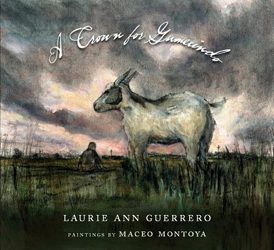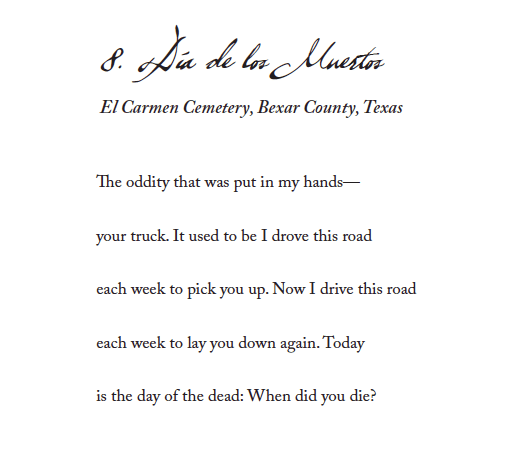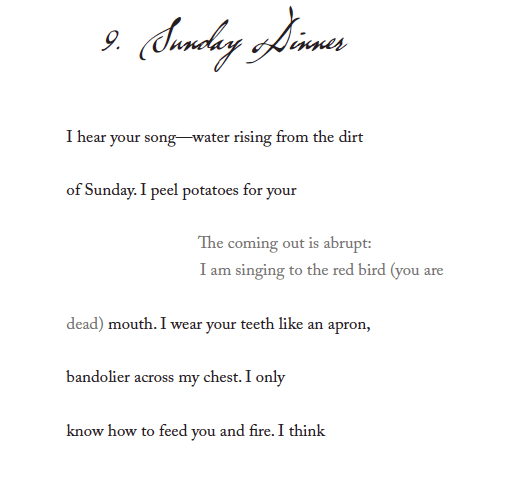
What lies at the heart of the heroic crown? A sequence of fourteen linked sonnets, the final line from each repeating as the first line of the next, the heroic crown, or sonnet redoublé, extends the constraints of the 14-line form, challenging poets to successive rounds of formal invention, culminating in an additional, fifteenth sonnet, itself composed of all the recycled lines. For John Donne, a perfecter of the form, the cyclical structure of the sonnet redoublé provided a perfect “hieroglyph of God,” as it alludes to a creation without beginning and with no end. Perhaps this helps to explain the popularity of the form, among contemporary poets, as a means to memorialize the dead. In its lyrical mimicry of the divine, the sonnet cycle offers fitting resistance to the ineffable finitude of death.
Among recent examples, Natasha Trethewey’s “Native Guard,” a unique crown of ten sonnets from the Pulitzer Prize-winning collection of the same name, gives voice to the regiment of black soldiers assigned to oversee Confederate POWs off the coast of Louisiana during the Civil War. Trethewey vitalizes this often overlooked facet of history through the diary of a fictional former slave, who composes his poems in a white master’s notebook, erasing and re-writing the record. Each sonnet marks a monthly entry, beginning in November, 1862, when the 1st, 2nd and 3rd Regiments of the Louisiana Native Guard became the first formally recognized black soldiers in the Union Army. While the work is thoroughly researched, Trethewey takes necessary liberties with the history and forgoes a typical rhyme scheme. Likewise, she alters the expected repetition of lines. From the opening stanzas, which introduce the speaker’s new method of remembrance:
I now use ink
to keep record, a closed book, not the lure
of memory -flawed, changeful- that dulls the lash
for the master, sharpens it for the slave.
December 1862
For the slave, having a master sharpens
the bend into work, the way the sergeant
moves us now to perfect battalion drill
Tretheway’s simple inversion, trading master for slave, builds a resonant tension between the form’s conventions and a desire to re-write history. Other poets flex the form further, like J. Michael Martinez in “Aporia,” from his first collection Heredities, who problematizes Chicanx identity through theory, language, and experiment and, to paraphrase Rigoberto González, hammers the crown into prose, preserving the repetitious language at the start and end of each stanza-graph. David Trinidad devotes his crown, “A Poet’s Death,” to Rachel Sherwood, a dear friend who died young. The poem’s title is drawn from the last line of “After Dark Vapours” by Keats (a novel move; re-directing the cycle). Another case in point, Marilyn Nelson’s A Wreath for Emmett Till commemorates the infamous lynching and funerary proceedings, with an aim at educating young readers.
This trend toward reclaiming the crown, to accept the form’s constraints while writing against them and, in many instances, employing the sonnet sequence to elegize the dead, finds unparalleled expression in A Crown for Gumecindo, the second collection by Laurie Ann Guerrero, author of the widely-praised, wickedly exquisite, A Tongue in the Mouth of the Dying (2013). This book-length heroic crown is a somber and sobering constellation of sonnets addressed to the poet’s grandfather, Gumecindo Martínez Guerrero, who passed away during the summer of 2013. In this severely personal, carefully structured sequence, Guerrero unpacks the event and aftermath, the meditations, vows, and reckoning that surface in the wake of loss. Amid the devastating imagery (“I wanted to take the shears to you: cut out the softened brain, the evaporating bone”) and blindsiding obsession (“weeds that sprout like vocal chords: he’s dead / they hum”), two unconventional facets of Guerrero’s crown stand out: the careful scarcity of words on each page, and the artwork -stunning charcoal and acrylic pieces by Maceo Montoya- interspersed throughout.
Like many contemporary sonneteers, Guerrero is selective in which formal elements she retains, bends, or breaks. The poems in A Crown for Gumecindo adhere to decasyllabic lines throughout, but ditch the strict iambic pentameter. Likewise, they forgo the sonnet’s typically incessant rhyme scheme, but retain rhyming couplets at the end of each individual piece, nodding to tradition. In most cases, the lines that repeat at the close and opening of each sonnet -the connective tissue of the heroic crown- appear without variation (“I hear your song—water rising from the dirt”), but occasionally change up, to shift tense and move forward a narrative (“You wake me before you pull the trigger. // You woke me before you pulled the trigger”) or, with subtle alteration, double down on a sense of unremitting devastation (“And one day in hot July, my kingdom gone. // One day in hot July, my king, you were gone”). But Guerrero’s most significant twist on the sonnet has less to do with formal elements per se, and instead concerns the visual presentation of the poems. By allowing the fourteen lines of each sonnet to span multiple pages, Guerrero resists immediate disclosure, and recasts the stanzaic arrangement, undoing the usual grouping of quatrains and couplet. An exemplary page from A Crown for Gumecindo:
“Dia de los Muertos” captures the sudden strangeness of once-familiar objects, the odd emptiness of ritual actions robbed of a vital presence. And while the inbent doubling of “pick you up” / “lay you down” mirrors the heroic crown’s formal refrain, the poem hesitates in the juxtaposition of two dates: a festive holiday to celebrate the dead, and the refusal to recall a date that must be truly unforgettable. In their parceled unfurling, Guerrero’s five lines form a new typography for the sonnet, neither Italian, nor English, maybe a new Latinx kind of line work. And, like the slowly unfolding petals of grief that peal away over time, the poem doesn’t reveal itself right away. The next page features one of Maceo Montoya’s paintings, a gauzy, iridescent portrait of Gumecindo hovering above the mud tones of rural earth. The poem ends: “I lay my ear to stone; it doesn’t hurt: / I hear your song—water rising from dirt.” The following sonnet presses the invention further:
Here, Guerrero introduces another typographical innovation, interrupting the sonnet with lines rendered in a faded, gray font. This isn’t the first time these ghost lines appear in the book. (An entire paragraph of faded prose serves as an epitaph to the crown). But “Sunday Dinner,” the ninth sonnet in the sequence, is the first instance in which the ghost lines intrude so extensively upon the body of the poem: the abrupt interruption of a redbird, death plucking potatoes from an open mouth. It’s an appropriate place for this unique intrusion, the ninth line in Shakespearean sonnets serving as the traditional volta, or turning point. Together with two of Montoya’s most haunting paintings -a portrait of a child at the dinner table with one blue eye ablaze, and the jagged branches of desert plants arcing toward a washed-out atmosphere- “Sunday Dinner” serves as a fulcrum for Guerrero’s heroic crown, a tipping point into a new reckoning in this sequence on death. The final lines of the poem are composed entirely of this ghost text, a fractured second-guessing of the death itself, the sonnet’s structure blown apart by disbelief:
The ghost text reappears in paragraphs between sonnets, but only intercedes again in the book’s closing poems. “Goodbye Sonnet,” the crown’s fifteenth and final entry, reiterates lines from all the previous pieces, drawing from the wide range Guerrero has traversed. Yet the lines synch perfectly, cohering with a handful of fragments and phrases in gray, into an epilogue that tracks the speaker’s evolving emotional state: “I’ve learned to keep my finger off the trigger, / spare the goats who’ve come to say hello, / shaking in their skins, faces split like mine- / like yours, mi muerto, the last time I saw you.” From anger and disbelief, the sonnet sequence moves its speaker and, with her, readers, through anger and depression, into a reconciliation and acceptance.
Eulogy, ode, tribute, lamentation; A Crown for Gumecindo achieves all of these, allowing its speaker to imagine a wandering, alternate Laurie Ann, “a Laurie Ann who left / behind three children, a sink full of dishes, / a man who kissed her as if the whole world lived in her mouth.” A Laurie Ann who seeks to summon Gumecindo, who sees him in brown goats baying at the gravesite, a rooster perched in a drive-thru, ladybugs nestled in paperbacks. Who sees the soft line between coincidence and omen blur, signs mistaken for symbols. A speaker who, like Tretheway’s soldier in “Native Guard,” immortalizes the memory by setting it to ink.
For all its possible variations, for all the liberties granted to poets who take up the sonnet redoublé, its most salient feature and perhaps its least flexible, are the strategic recitations that link each poem to the next, accumulating into the hymnal fifteenth sonnet, a chant-like compilation of lyrics. As Tim Z. Hernández notes, these incantations counter the natural and supernatural forces that cause the demise of loved ones. Perhaps the sonnet cycle assists in this resistance, grants the poet license to work with its technique. After all, it’s one thing to grieve for a lost love. It’s another to do so publicly. And it’s another endeavor entirely to process loss and love through art for an audience. Guerrero should be commended for inviting readers to participate in this process, for sharing her grief and her gift. A Crown for Gumecindo goes beyond honoring its subject and ensures the poet’s grandfather -his name, his legacy- will never be forgotten.








